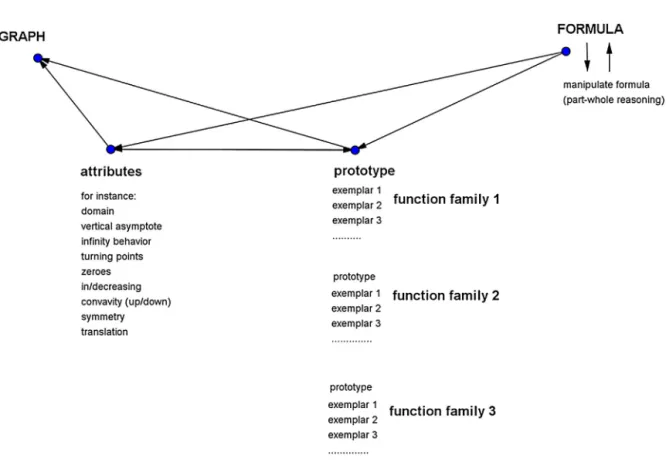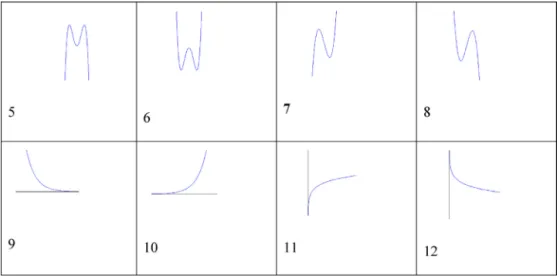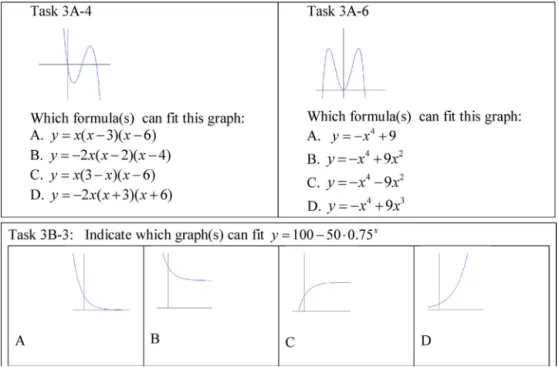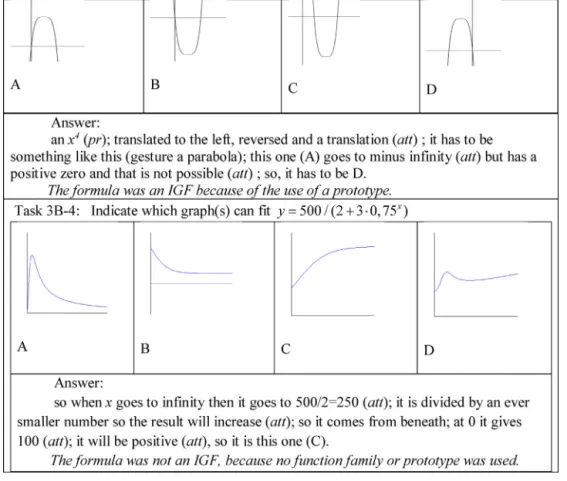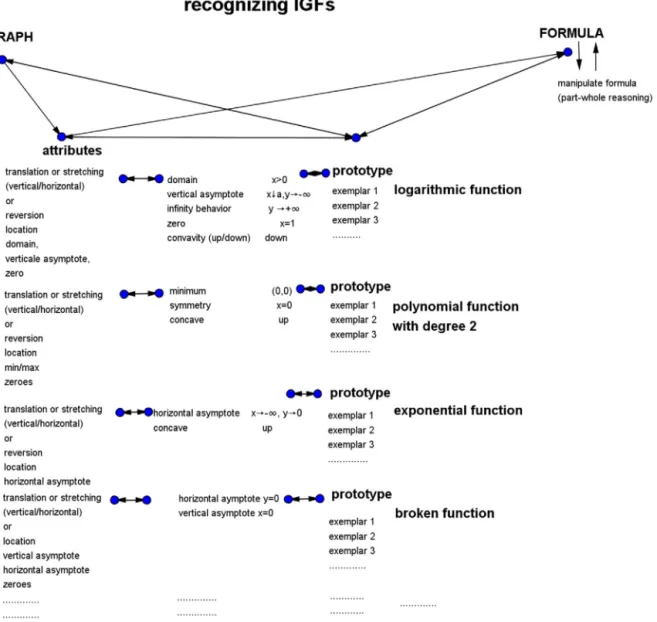Peter
M.G.M.
Kop
a,∗,
Fred
J.J.M.
Janssen
a,
Paul
H.M.
Drijvers
b,
Jan
H.
van
Driel
caIclon,LeidenUniversity,TheNetherlands
bFreudenthalInstitute,UtrechtUniversity,TheNetherlands
cMelbourneGraduateSchoolofEducation,TheUniversityofMelbourne,Australia
a
r
t
i
c
l
e
i
n
f
o
Articlehistory:
Received10June2016
Receivedinrevisedform12January2017 Accepted25January2017
Availableonline9February2017
Keywords:
Graphingformulas Experts’recognition Functionfamilies Prototypesandattributes
a
b
s
t
r
a
c
t
Aninstantlygraphableformula(IGF)isaformulathatapersoncaninstantlyvisualize usingagraph.TheseIGFsarepersonalandserveasbuildingblocksforgraphingformulas byhand.Thequestionsaddressedinthispaperarewhatexperts’repertoiresofIGFsareand whatexpertsattendtowhilerecognizingtheseformulas.Threetasksweredesignedand administeredtofiveexperts.Thedataanalysis,whichwasbasedonBarsalouandSchwarz andHershkowitz,showedthatexperts’repertoiresofIGFscouldbedescribedusingfunction familiesthatreflectthebasicfunctionsinsecondaryschoolcurriculaandrevealedthat experts’recognitioncouldbedescribedintermsofprototype,attribute,andpart-whole reasoning.Wegivesuggestionsforteachinggraphingformulastostudents.
©2017ElsevierInc.Allrightsreserved.
1. Introduction
Algebraicconcepts,likefunctions,canbeexploredmoredeeplythroughlinkingdifferentrepresentations(Duval,2006;
Heid,Thomas,&Zbiek,2012).Graphsandalgebraicformulasareimportantrepresentationsoffunctions.Graphsseemtobe
moreaccessiblethanformulas(Leinhardt,Zaslavsky,&Stein,1990;Moschkovich,Schoenfeld,&Arcavi,1993).Inaddition, graphsgivemoredirectinformationoncovariation,thatis,howthedependentvariablechangesasaresultofchangesof theindependentvariable(Carlson,Jacobs,Coe,Larsen,&Hsu,2002).Agraphshowsfeaturessuchassymmetry,intervals ofincreaseordecrease,turningpoints,andinfinitybehavior.Inthisway,itvisualizesthe“story”thatanalgebraicformula tells.Thereforegraphsareimportantinlearningalgebra,inparticularinlearningtoreadalgebraicformulas(Eisenberg&
Dreyfus,1994;Kieran,2006;Kilpatrick&Izsak,2008;NCTM,2000;Sfard&Linchevski,1994).
Studentshavedifficultiesinseeingafunctionbothasaninput-outputmachineandasanobject(Ayalon,Watson,&
Lerman,2015;Gray&Tall,1994;Oehrtman,Carlson,&Thompson,2008;Sfard,1991).Graphsappealtoagestalt-producing
ability,andinthiswaycanhelptoconsolidatethefunctionalrelationshipintoagraphicalentity(Kieran,2006;Moschkovich etal.,1993).Graphsarealsoconsideredimportantinproblemsolving.Graphsareusedforunderstandingtheproblem situation,recordinginformation,exploring,andmonitoringandevaluatingresults(Polya,1945;Stylianou&Silver,2004).
So,theabilitytoswitchbetweenrepresentations,representationversatility,inparticularconversionsfromalgebraic formulastographs,isimportantinunderstandingalgebraandinproblemsolving(Duval,2006;NCTM,2000;Stylianou,
2011;Thomas,Wilson,Corballis,Lim,&Yoon,2010).
∗ Correspondingauthor.
E-mailaddress:koppmgm@iclon.leidenuniv.nl(P.M.G.M.Kop).
http://dx.doi.org/10.1016/j.jmathb.2017.01.002
Inapreviousstudyaframeworkwasdevelopedtodescribestrategiesforgraphingformulaswithoutusingtechnology
(Kop,Janssen,Drijvers,Veenman,&VanDriel,2015).Intheframework,itisindicatedhowrecognitionguidesheuristic
search.Whenonehastographaformulatherearedifferentpossiblelevelsofrecognition:fromcompleterecognition(one immediatelyknowsthegraph)tonorecognitionatall(onedoesnotknowanythingaboutthegraph).Foreverylevelof recognitiontheframeworkprovidesstrongtoweakheuristics.
Forthetwohighestlevelsofrecognitionthegraphiscompletelyrecognizedortheformulaisrecognizedasamemberof afunctionfamilywhosegraphcharacteristicsareknown.Forinstance,atthehighestlevelofrecognitionthegraphofy=x2
isinstantlyrecognizedasaparabolawithminimum(0,0).Atthesecondlevelofrecognition,y=4·0.75x+3isrecognizedas
amemberofthefamilyofdecreasingexponentialfunctions,andsothehorizontalasymptoteisreadfromtheformula.In thiswaythegraphcanbeinstantlyvisualized.Anotherexampleatthislevel:y=−x4+6x2isrecognizedasapolynomial
functionofdegree4;becauseofthenegativeheadcoefficientitsgraphhasanM-shapeoran-shape;ashortinvestigation of,forinstance,thezeroeswillinstantlygivethegraph.
Atthesetwohighestlevelsofrecognitionintheframework,formulascanbeinstantlylinkedtographs.Therefore,these formulasaredefinedasinstantlygraphableformulas(IGF).AlargesetofIGFsisbeneficialtoproficiencyingraphingformulas. Thecurrentstudywasfocusedonexperts’recognitionprocesseswhendealingwithIGFs.Forthisstudywedefinedanexpert asapersonwithatleastamaster’sdegreeinmathematicsandatleast10yearsofexperienceteachingatthesecondary orcollegelevel,withexperienceingraphingformulasbyhand.Althoughtheseexpertsareexpectedtobeabletoinstantly linkmanyformulastographs,theirrepertoiresofIGFsremainunknown.Inaddition,weinvestigatedwhatexpertsattend towhenrecognizingIGFs.ThisinformationmightgivesuggestionsforarepertoireofIGFsforstudentsandforafocusin teachingstudentsIGFs.
2. Theory
2.1. Cognitiveunitsasbuildingblocks
IGFscanbeseenasbuildingblocksinthinkingandreasoningwithandaboutformulasandgraphs.BarnardandTall(1997)
introducedtheconceptof“cognitiveunit”,anelementofcognitiveknowledgethatcanbethefocusofattentionaltogether atonetime.Forexperts,well-connectedcognitiveunitscanbecompressedintoanewsinglecognitiveunitwhichcan beusedasjustonestepinathinkingprocess(Crowley&Tall,1999).Inthiswayexperts’knowledgeiswellorganizedin hierarchicalmentalnetworkswithcomplexcognitiveunits,whichcanbeenlistedwhennecessary(Campitelli&Gobet,
2010;Chi,Feltovich,&Glaser,1981;Chi,2011).
AsIGFsarecognitiveunitsingraphingformulas,theycanbecombined(addition,multiplication,chaining,etc.)andcan formnew,morecomplexIGFs.Forinstance,whendealingwithy=−x4+6x2,novicesmayrecognizetheIGFsy=−x4and y=6x2andhavetocombinethesetwoIGFstodrawagraph,whereasy=−x4+6x2isanIGFforexperts,whorecognizea
4thdegreepolynomialfunction.Forexperts,aformulalikey=x2−6x+5cantriggerothercognitiveunits,like“itsgraph
isaparabolawithaminimumvalue”,andtheequivalentformulasy=(x−1)(x−5) andy=(x−3)2−4,whichcangive informationaboutthezeroesandtheminimumvalue,etc.Expertsareexpectedtohavemore,andmorecomplex,IGFsthan novices,whichgenerallyenablethemtographformulaswithfewerdemandsontheworkingmemory(Sweller,1994).
Thecurrentstudywasfocusedonrecognition:inparticular,whichformulasand/orfunctionfamilieswereinstantly recognizedbyexpertsandhowtherecognitionprocessescanbedescribed.
2.2. RecognitiondescribedusingBarsalou’smodelwithprototype,attribute,andpart-wholereasoning
Barsalou(1992)showedhowhumanknowledgeisorganizedincategoriesorconcepts.Peopleconstructthesecategories
basedonattributes.Whenataskrequiresadistinctiontobedrawnbetweenexemplarsofacategory,peopleconstructnew attributesandinthiswaynewcategories(Barsalou,1992).Forinstance,fortheconceptbird,attributes(variables)likesize, color,andbeak,withseveralvalues,canbeusedtodistinguishdifferentexemplars.Categoriescanhavealargediversityof exemplars,buthaveagradedstructure(Eysenck&Keane,2000;Barsalou,2008).Someexemplarsinacategoryaremore centraltothatcategorythanothers;thesearecalledprototypes.Forinstance,arobinisconsideredamoretypicalexample ofabirdthan,forinstance,achickenorapenguin.Whendealingwithexemplarsofacategory,peopletendtoassociate prototypicalfeatureswiththeseexemplars(Barsalou,2008;Schwarz&Hershkowitz,1999).Thetendencytoreasonfrom prototypescanposeproblems.Sinceconceptformationisnotnecessarilydoneusingpuredefinitions,WatsonandMason
(2005)emphasizedtheneedtogobeyondprototypesandtosearchfortheboundariesofaconcept.Inthiswayonebecomes
awareofthedimensionsofpossiblevariationandineachdimensionoftherangeofpermissiblechange(Billsetal.,2006;
Sandefur,Mason,Stylianides,&Watson,2013;Watson&Mason,2005).Thepersonalexamplespace,thecollectionof
examplesandtheinterconnectionbetweentheexamplesapersonhasathis/herdisposal(theaccessibleexamplespace), playamajorroleinhowapersonmakessenseofthetaskshe/sheisconfrontedwith(Watson&Mason,2005;Goldenberg
&Mason,2008).VinnerandDreyfus(1989)usedconceptimagetoemphasizethepersonalcharacterofpeople’smental
theexemplar(s)withthesetofhighestfrequencyofattributevaluesinthecategoryorwiththehighestcorrelationwith otherexemplarsinthecategory(Barsalou,1992).Prototypesaretheexamplesthatareacquiredfirstandareusuallythe examplesthathavethelongestlistofattributes:thecriticalattributesofthecategoryandtheself-attributes(non-critical attributes)oftheexemplar(Schwarz&Hershkowitz,1999).Prototypesareusedasareferencepointforjudgingmembership ofthecategory:anexemplarisjudgedtobeamemberofacategoryifthereisagoodmatchbetweenitsattributesandthose ofthecategoryprototype(Barsalou,2008;Eysenck&Keane,2000).Whenaskedforaprototypeofacategory,itisexpected thatapersonwillnotuseadefinitionofprototypebutwilluseageneralideaaboutwhatprototypesare:namely,the mostcentralexemplar(s)ofacategoryfromhis/herpersonalperspective.Asaconsequence,whendealingwithacategory,
theprototypesarethefirstexamplesthatcometoone’smindandarethenaturalexamplesthatareusedwithoutany
explanation.Examplesinthedomainofgraphingformulasincludeprototypicalformulaslikey=x2andy=x3,withtheir
prototypicalgraphs.Inthisstudyweusedthetermprototypereasoninginthisway.
Attributeunderstandingcanbedefinedastheabilitytorecognizetheattributesofafunctionacrossrepresentations
(Schwarz&Hershkowitz,1999).Forinstance,fromtheformulay=(x−1)(x−5),itisconcludedthatitsgraphisaparabola,
ithaszeroesatx=1andatx=5andasymmetryaxisatx=3.Theseattributesorpropertiesofthisfunctioncanberecognized inthegraphical,tabular,andalgebraicrepresentations.
Inhisproperty-orientedviewoffunctions,Slavit(1997)usedproperties(orattributes)likesymmetry,monotonicity, horizontalandslantasymptotes,intercepts(zeroes),extrema,andpointsofinflection.
Dependingonthetask,peopleconstructattributestobeabletodistinguishexemplars:inthisstudy,formulasandgraphs
(Barsalou,1992).Todistinguishdifferentgraphsof4thdegreepolynomialfunctionsinFig.1,onecanuseattributeslike
symmetry,infinitybehavior,numberofturningpoints,numberofzeroes,andlocationofzeroesrelativetothey-axis.When relatingformulasandgraphs,asingraphingformulas,onechoosesorcreatesattributestofocusonfeaturesofformulasand graphs.Wecallthisreasoningaboutattributesandtheirvaluesattributereasoning.
Part-wholereasoningreferstotheabilitytorecognizethatdifferentformulasordifferentgraphsrelatetothesameentity: inthiscase,tothesamefunction.Inthegraphicalrepresentation,differentscalingcanresultindifferentpicturesofgraphs belongingtothesamefunction.Inthealgebraicrepresentation,formulamanipulationcanresultindifferentformulasofthe samefunction:forinstance,y=x2−4x,y=(x−2)2−4,andy=x(x−4).Fromthesedifferentformulasdifferentattributesof
thegraphcanberead.Therefore,part-wholereasoningisimportantintherecognitionofIGFs.
Forattributereasoningandpart-wholereasoningonehastograspthestructureofaformula.Intheliteraturethisiscalled symbolsense(Arcavi,1994).Symbolsenseisaverygeneralnotionof“whenandhow”tousesymbolsandhasseveralaspects, suchastheabilitytoreadthroughalgebraicexpressions,toseetheexpressionasawholeratherthanaconcatenationof letters,andtorecognizeitsglobalcharacteristics(Arcavi,1994).PierceandStacey(2001)usedalgebraicinsighttocapture thesymbolsenseintransformationalactivitiesinthe“solving”phaseofproblemsolving(PierceandStacey,2001).The algebraicinsightisdividedintwoparts:algebraicexpectationandtheabilitytolinkrepresentations.Algebraicexpectation hastodowithrecognitionandidentificationofobjects,forms,keyfeatures,dominantterms,andmeaningsofsymbols
(Kenney,2008;Pierce&Stacey,2001).Algebraicinsightisshownwhenapersonhasexpectationsaboutgraphsthatare
linkedtofeaturesofthesymbolicrepresentationandwhenequivalentalgebraicexpressionsarerecognized(Ball,Stacey,&
Pierce,2003;PierceandStacey,2001,2004).
Thethreeaspectsprototype,attribute,andpart-wholereasoningfromSchwarzandHershkowitzcanbeusedtodescribe therecognitionprocessingraphingformulas.ABarsaloumodelforrecognizingIGFsisformulatedinFig.2.Inthecase ofgraphingformulas,itisdifficulttomentionallpossiblevalues.Forinstance,theattribute“zeroes”canhavevalueslike 0,1,2,3,toindicatethenumberofzeroes,butalsothelocationcanbeusedasvaluesofanattribute(forinstance,azeroat
x=5).Forthesakeofreadability,thevaluesbelongingtotheattributesareomittedinFig.2.
Fig.2. IGFsintheformofaBarsaloumodelbasedonSchwarzandHershkowitz(1999).
prototypeofafunctionfamily.Itisthenpossiblethatthegraphisdirectlyknown,orthat,usingattributereasoning,agraph canbevisualized.
Someexamplescanillustratethisrecognitionprocess.InIGFy=4·3x+2theprototype3xcanberecognized(prototype
reasoning),andviaatranslation(attributereasoning)thegraphcanbevisualized.InIGFy=−2x(x−3)(x−6),theprototype
x3canberecognized,−x3asareversion(attributereasoning),andviazeroesatx=0,x=3,x=6(attributereasoning)the
graphcanbevisualized.However,wheny=−2x(x−3)(x−6)isnotrecognizedasamemberofafunctionfamilyorprototype ofafunctionfamily,theformulaisnotanIGF(Kopetal.,2015).Inthiscasethegraphhastobeconstructedby,forinstance, reasoningaboutattributeslikeinfinitybehaviorandzeroes.If,whengraphingy=4x−2,theformulacanberewrittento y=4/x2(part-wholereasoning)andrecognizedasa1/x2(prototypereasoning),theformulaisanIGF.Butwhenfromthe
formulay=4/x2itisreadthatithasaverticalasymptoteatx=0,andthatalloutcomesarepositiveandwhenx→±∞then y=0(infinitybehavior),thenwesaythatthegraphisconstructedthroughqualitativereasoning(Kopetal.,2015),andso theformulaisnotanIGF.
2.3. Globalandlocalperspectives
Covariationalreasoningisessentialforgraphingformulas.Incovariationalreasoning,oneisabletoimaginerunning throughallinput-outputpairssimultaneouslyandsotoreasonabouthowafunctionisactingonanentireintervalofinput values(Carlsonetal.,2002).InrecognizingIGFsonehastohaveapictureofthefunctionasanentity.Intheliteraturethis perspectiveofthefunction,seeingthefunctionasawhole,isalsoaddressedastheobjectorglobalperspective(Confrey
&Smith,1995;Even,1998;Gray&Tall,1994;Oehrtmanetal.,2008;Sfard,1991).Thereisalsoanotherperspectiveofthe
function,namely,toseeafunctionasaninput-outputmachine.Thisperspectivehastodowiththefundamentalviewon functions(whatitmeansthatacertainy-valuebelongstoagivenx-value),andisaddressedasthepointwise,process, orcorrespondenceperspective.Switchingbetweenbothkindsofperspectiveisnecessaryforreasoningaboutfunctions.
Slavit(1997)spokeaboutthelocalandglobalnatureoffunctionalgrowthpropertiesinaddressingbothkindsofperspective
(Slavit,1997).Theglobalgrowthpropertiesconcernattributeslikesymmetry,monotonicity,horizontalandslantasymptotes,
Fig.3.Anumberofthecardsusedintask1.
usingthesepropertiesorattributes.Beforethecurrentresearch,itwasunknownwhichattributesexpertsuseinrecognizing IGFs.
2.4. Researchquestions
Inthecurrentstudywefocusedonexperts’repertoiresofformulasthatcanbeinstantlyvisualizedusingagraph(IGFs) andontheirconceptimagesofIGFs,withattributes,prototypes,andpart-wholereasoning.Weexpectedthatexpertswould havelargerepertoiresofIGFsthatarestructuredincategories.However,wedidnotyetknowwhatanexpertrepertoireof IGFswouldbe.
Weexpectedexpertstobeabletomanipulatealgebraicformulas(part-wholereasoning),tousesymbolsenseandin particularalgebraicinsight,andtousesetsofattributeswithvaluesetstodistinguishdifferentgraphs.However,wedidnot knowwhichprototype,attribute,andpart-wholereasoningtheywoulduseinlinkingformulasandgraphsofIGFs.
Thisleadtothefollowingresearchquestions:
Canwedescribeexperts’repertoiresofinstantgraphableformulas(IGFs)usingcategoriesoffunctionfamilies? WhatdoexpertsattendtowhenlinkingformulasandgraphsofIGFs,describedintermsofprototype,attribute,and
part-wholereasoning?
3. Method
Thecurrentstudycanbecharacterizedasanexploratorystudy,inwhichweinvestigated“snapshots”ofexperts’concept imagesoffunctionfamilieswiththeiralgebraicformulasandgraphs.
3.1. Tasks
Threedifferenttasksweredevelopedtoelicittheexperts’repertoiresofIGFsandtoexploretheexperts’prototype, attribute,andpart-wholereasoning:acard-sortingtask,amatchingtask,andamultiplechoicetask.
Card-sortingtasksareoftenusedinelicitingstructuredknowledge(Chietal.,1981;Jonassen,Beissner,&Yacci,1993;de
Jong&Ferguson-Hessler,1986;Goldenberg&Mason,2008;Sandefuretal.,2013).
Intask1,60formulasweregivenandtheparticipantswereaskedtocategorizethemaccordingtotheirgraph.After this,theywereaskedtogiveanameandaprototypicalformulaforeachoftheircategories.Westructuredthistaskby addinggraphstothecardsshowingtheformulas.Whensuchtasksaregivenwithoutstructuringbeforehand,gettinga completepictureorcomparingtheresultscanposeproblems,becauseofthedifferentcriteriathatcanbeusedtosortthe cards(Ruiz-Primo&Shavelson,1996).Becauseweaddfourgraphstothe60cardswithformulas,theparticipantswere explicitlycompelledtofocusonthegraphsoftheformulas.Wedidnotindicatewhetheraparticipantshoulddiscriminate betweenparabolaswithamaximumorminimumbecausethelevelofdetailcanbeanindicatorofexpertise.Fig.3shows 20cardsfromtask1.Mostoftheseformulas,butnotall,arerelatedtooneofthebasicfunctionfamilies,whicharestudied ingrades10–12:y=xn,y=ax,y=log
2(x),y=1/x,y=√x,y=ln(x),y=ex.Since,weusedthebasicfunctionsfromsecondary
Fig.4.Somealternativesoftask2.
InTask2,thematchingtask,alistof40formulaswasgivenandtheparticipantswereaskedtoselectthecorrectalternative outof21alternatives:20graphsandonealternativestating“noneofthese”.Thislastalternativewasprovidedtodiscourage guessing.Inthistaskthefocuswasoninstantlinkingofformulastotheglobalshapeofgraphs.Thereforeastricttime limitwasusedtoencouragerecognitionandtodiscourageconstructionofagraph.Wechoseamatchingtaskwithmany alternativesratherthanagraphingtasktoindicatethelevelofdetailthatwasneeded:theexpertshadtorecognizethe globalshapeofthegraphofthegivenformula.
The formulas used in this task resembled the formulas used in the first task. The following are some
exam-ples:y=2x(x−2)(x+4);y=6x2−2x4; y=e2x+1;y=x−4/x; y=4−2x+x/4; y=4/2x; y=√x−6+2;y=ln(e2·x); y=2x−4; y=2(x−1)4−4;y=
8−x2;y=ln(4/x);y=9x/√3x;y=ln(e2·x).EightofthealternativegraphsareshowninFig.4.Task2wasalsodevelopedtoelicitparticipants’repertoiresofIGFs.Thereforesomefunctionswereaddedthatdonot belongtothefunctionfamiliesofbasicfunctions,forinstance,y=
8−x2,y=30/(x2−16),y=x−4/x,becausewewantedtoinvestigatetheboundariesoftheexperts’repertoiresofIGFs.Becausetheformulasusedweresimilartothoseintask1, thistaskwasusedtovalidatetheresultsoftask1.When,forinstance,intask1nodistinctionwasmadebetweenincreasing anddecreasingparabola,butintask2thisdistinctionwasmade,itwasconcludedthattheparticipantcouldindeedmake suchadistinction.
Tasks3Aand3B,thinkingaloudmultiplechoicetasks,weredevelopedtoelicittheparticipants’prototype,attribute,and part-wholereasoningandinthiswaytogetmoredetailedknowledgeoftheparticipants’conceptimages.Theparticipants wereaskedtochoosethecorrectalternativeoutoffouralternatives.AsimilartaskwasusedbySchwarzandHershkowitz
(1999)intheirstudyofconceptimagesoffunctions.Bothtasksconsistedofsixitems.Intask3Baformulawasgivenandthe
expertshadtofindthecorrectgraph.Intask3Aagraphwasgivenandtheexpertshadtoprovideaformula.Ingeneral,tasks like3Aareconsideredtobemorechallenging.Butthisisnotclearwhendealingwiththefunctionfamiliesofwell-known basicfunctions.Inthiswaywegotmoredetailedinformationabouttheexperts’conceptimagesofIGFs.Threeexamplesof thistaskareshowninFig.5.
Theformulaswereagainchosenfromthesamesetoffunctionsasintasks1and2.Participantshadtoconsiderall alternativesbecausemorethanonealternativecouldbecorrect.
Intasks1and2thefocuswasonsketchesofgraphs;inthistask,moredetailedanswerswereneeded.Forinstance,in tasks1and2itwasnotnecessarytodistinguishy=−2x(x−2)(x−4)andy=−2x(x+3)(x+6),butintask3thisdistinction hadtobemade(seetask3A-4inFig.5).
3.2. Participants
Fig.5.Someexamplesoftask3:task3A-4,3A-6,3B-3.
3.3. Dataanddataanalysis
3.3.1. Datacollectionprocedure
Writteninstructionswerehandedoutforeverytask,togetherwithanindicationofthetimeneededtoperformthetask. Fortask1,atimeindicationofmaximum40minwasgiven;fortasks2and3,20min.Foralltasks,thetimeneededwas recorded,asthetimerequiredtoperformataskcanbeanindicationofexpertise.Duringthetasksthefirstauthoronly emphasizedtheneedtokeeponthinkingaloudwhentheexpertsstoppedtalking.Aftereachtask,thefirstauthoraskedthe expertstolookbackandtodescribethestrategies,theyhadusedinthetask.Theinterviewswerevideotaped.
Intask1,thecard-sortingtask,60cardswerelaidonatableandtheparticipantscouldphysicallygrouptheformulas intodifferentcategories.Afterwards,thecategoriesweregluedonalargesheet.Theparticipantsthenwrotethecategory namesandtheprototypicalformulasforeachcategory.Intask2andtask3,theparticipantsfilledintheanswersonaform. Duringtasks1and3theparticipantswereaskedtothinkaloud;thiswasvideotaped.Thinkingaloudisconsideredto givereliableinformationabouttheproblem-solvingactivitieswithoutdisturbingthethinkingprocess(Ericsson,2006).For task3thethinking-aloudprotocolsweretranscribedinordertoanalyzetheprototype,attribute,andpart-wholereasoning.
3.3.2. Dataanalysis
3.3.2.1. Task1.Theaimoftask1wastogatherinformationonwhichcategoriesexpertsuseintheirrepertoiresofIGFs.It wasexpectedthatexpertswouldusesalient,globalpropertiesofgraphs,likesymmetry,in/decreasing,verticalasymptotes, infinitybehavior,andnumberofturningpoints,tocategorizetheirIGFs.Basedonthesesalientproperties,thefirstauthor madeatheoretical,hypotheticalexperts’categorizationbeforethestartofthisstudy.Thecategorizationsofthefiveexperts werecomparedwitheachotherandwiththefirstauthor’scategorization.Basedonthesefindingsacommoncategorization wasconstructed.Thiswasdoneinseveralsteps.First,commonelementsinthecategoriesandprototypesintheexperts’ categorizationsandthefirstauthor’scategorizationweredetermined.Fromthesefindingsapreliminarycommonexpert categorizationwasformulated.Inthesecondstep,thelevelofdetailwasconsidered.Ahigherlevelofdetailmeantthat subcategorieswereused.Ifoneormoreexpertsusedahigherlevelofdetail,thenthislevelofdetailwasusedinthe(final) commonexpertcategorization.Inthelaststep,thedistancesbetweenindividualcategorizationsandthecommonexpert
categorizationwerecalculated.Weconsideredwhethersmalladjustmentsinthecommonexpertcategorizationwould
resultinalowerminimumofthetotalofalldistances.Whennoprogressioncouldbemade,thefinalcommonexpert
categorizationwasfound.
Todeterminethedistancebetweenanindividualcategorizationandacommoncategorization,thefollowingprotocol
wasused:
-Ifnosubcategoriesweremadeintheindividualcategorizationandthecommonexpertcategorizationmadeadistinction betweenincreasinganddecreasing,thenthedistanceincreasedby+2(forinstance,nosubcategoriesbetweenparabolas withmaximumandparabolaswithminimumgaveanincreaseofthedistanceby+2ifthecommonexpertcategorization madethisdistinction)
-Iftwocategoriesofthecommonexpertcategorizationweremergedintheindividualcategorization(otherthanthe distinctionbetweenincreasinganddecreasing),thenthedistanceincreasedby+4(forinstance,3rdand4thgradefunctions wereputtogetherinonecategory)
-Ifa completely newcategory, differentfromthecommon expertcategorization, wasformulated,then thedistance
increasedby+6.
3.3.2.2. Task2.Inthistaskthenumbersofmistakesperexpertwerecounted.Themistakeswereindicatedinatablein ordertoseewhethertheyweremadeinparticularfunctionfamilies.
3.3.2.3. Task3.Toanalyzetheresultsoftask3,thetranscriptswerecutintofragmentswhichcontainedcrucialstepsof explanations:ideaunits.Ideaunitsareprimitiveelementsinthejustificationsofparticipants(Schwarz&Hershkowitz, 1999).TheseideaunitswereencodedusingtheelementsfromFig.2:prototype,attribute,orpart-wholereasoning.
Sinceprototypesarethenaturalexamplesofcategoriesthatcanbeusedwithoutanyexplanation,graphsandformulas thataparticipantusedasthestartofareasoningprocesswereconsideredprototypesfortheexpert.Ifnoprototypereasoning wasusedorfunctionfamilywasmentioned,wesaidthattheformulawasnotanIGF,andthatthegraphwasconstructed.
Thefragmentsoftheprotocolswereencodedasfollows:
-pr(prototypereasoning):onlyaprototypicalexemplarwasmentioned;forinstance,“itlookslikealog”,“itisanxinthe power6”,“itisanexpo”,“itisanoscillation”.Ifafunctionfamilywasmentioned,likein“itisanexponentialfunction”or “4thdegreepolynomial”,thiswasconsideredprototypereasoning
-att(attributereasoning):anattributewasmentioned;forinstance,“thisonehasaverticalasymptoteatx=0”,“itisalways positive”,“itgoestominusinfinity”.
-pw(part-wholereasoning):theformulawasmanipulatedtoanequivalentformula,forinstance,y=4x−2toy=4/x2
-con(construction):nofunctionfamilyorprototypewasmentioned,theformulawasnotanIGF:thegraphwasconstructed through,forinstance,attributereasoningorcalculatingpoints.
WegivetwoexamplesoftheencodinginFig.6.
4. Results
4.1. Resultsoftask1
Theexperts’andauthors’categorizationsareshowninAppendixA.Theexpertsshowedagreatdealofagreementintheir choicesofcategories,namesofthesecategories,andprototypesofthecategories.OnlyexpertSusedadifferentapproachin hiscategorizationofpolynomialfunctions.Hebasedhiscategorizationonthenumberofturningpoints.Theotherexperts allusedthedegreeofpolynomialfunctions.The4thdegreepolynomialfunctionsweredividedintographswithaW-form, aM-form,andaV-form(orastheexpertsmentioned,“increasingordecreasing”).Nolargedifferenceswerefoundon exponentialfunctionsandlogarithmicfunctions,althoughsomeexperts(PandR)madenodistinctionbetween“normal” and“reversed”graphs(forinstance,y=exversusy=e−xandy=ln(x)versusy=−ln(x)).Allexpertsagreedonlinearbroken functionsandsquare-rootfunctions.Moredifferenceswerefoundinthecategoriesofpowerfunctions,whereonlyexpert Qmadedistinctionsbasedondomainand/oronconcavity.
Intheconstructionofthecommonexpertcategorization,thedistancesbetweenindividualcategorizationsandthe commonexpertcategorizationwerecalculated.ThefinalcommonexpertcategorizationisshowninTable1.
Thefollowingdistancesfromthefinalcategorizationwerefound:11,3,19,20,and15(forP,Q,R,S,andT,respectively). Theexpertsneededanaverageof18min:23,20,11,14,and21min(forP,Q,R,S,andT,respectively).
Forthistasktheexpertsusedalotofpart-wholereasoninginordertocategorize,forinstance,thefollowingformulas
correctly:ln(e2x),(1−x)(2+x)+x2,ln(1/x),x(x−1)/(x+1)(x−1),(2x13) 5
.
Fig.6.Examplesoftheencodingoffragmentsofprotocolsoftask3.
Table1
Commonexpertcategorization.
Categories:
Linear
x+5(4−x),ln(e2x),(1−x)(2+x)+x2 Parabola
parabolawithmax:x(9−x),−(x−3)2+2,(x+5)(3−x),2x−3(x+2)(x−2),−(x−1)2+2(x−1)+6; parabolawithmin:x2−7(x−5),(6−x)2,x2+(−x+1)2
3rddegreeoscillation
(x2−7)(x−5),2(x−3)2(x+3),2x3+4x2−16x,x3−9x,e3ln(x) 4thdegree
W-shape:x4−16x2+28,(x2−7)2
;(6edegreeW-shape:3(x4−6)(x2−8)); M-shape:−3(x2−4)(x2−6),2x3(6−x);V-shape:(x+3)4−9,x2(9+x2) Exponential
increasing:4−3+x,2.(√2)x;decreasing:18·0.3x,26−x,8e−x,10−2x+5,8/3x;
reversedexponential:6−2x;100−ex
Logarithmic
inceasing:ln(e2·x),1+2log(x),ln(x)+ln(2);decreasing:−ln(x),ln(1/x) distractor:1/ln(x)
Hyperbola
hyperbola:x(x−1)/(x+1)(x−1),(4x+2)/x,1−5/(x+1)
powerfunctionswithnegativeoddpower:8x−3;withnegativeevenpower:2/x4,3x−2 slantasymptote:x−4/x;twoverticalasymptotes(x2−1)−1
,2/x−3/(x−1) ‘Roots’
increasing‘√x-like’:3√x+6,2√x−6;(100x)12;decreasing‘√x-like’:4√10−x,(2−x)12+2
halfacircle:
8−x2;V-shape:8+x2 powerfunctionsexponent‘1
3-like’<1:2
3
√
x,8√3x4/2x;exponent‘1
3-like’>1:(2x 1 3)
5
;exponent‘11 2-like’:2x
Table2
Resultsoftask2.
Participant Numbermistakes Mistakes
P 3 (4x+1)/(x+2);7x√x;10/x3
Q 1 (4x+1)/(x+2)
R 1 (4x+1)/(x+2)
S 0
T 5 6x2−2x4;2x−4;4−2x+x/4;(4x+1)/(x+2);5x7
Table3
Timeneededfortask3Aand3B,thetotalnumberofmistakes,andthenumberofIGFsandconstructions.
Participants Time3A Time3B Numberofmistakes NumberofIGFs Numberofconstructions
P 4:54min 7:44min 0 10 2
Q 4:16min 2:13min 0 11 1
R 3:56min 6:27min 0 9 3
S 4:02min 2:44min 0 6 6
T 6:16min 2:46min 0 9 3
detailedcategorizationwouldbepossible,butnotwithoutcalculations:“InthenextstepIwouldhavetomakecalculations;
Iwouldnottrustmyselftosaymoreaboutthiscategorizationoffthetopofmyhead”(expertQ).
4.2. Resultsoftask2
Theresultsoftask2(seeTable2)showedthatthreeoutofthefiveexpertsmadenomistakesoronlyonemistake.Most
mistakesweremadewiththeformulay=(4x+1)/(x+2).Fourofourexpertsselectedthealternativewiththeincreasing hyperbola.Fromtheotheralternativesitcouldhavebeenconcludedthatadistinctionhadtobemadebetweenanincreasing andadecreasinghyperbola.Sinceastricttimelimitofonly30sforoneformulawasusedandallexpertsfinishedthistask easilywithinthistimelimit,itwasconcludedthatalltheformulasthatdidnotbelongtothealternative“noneofthese” couldbeconsideredIGFsfortheexperts.
Fromtheobservationsandinterviewswelearnedthatallexpertsfirstexaminedthe20graphalternativesandhada globalviewoftheformulastogetanimpressionofwhichaspectswouldplayaroleinthistaskandwhattheyhadtofocus on.Allexpertsreadalmostallgraphsbymentioningafunctionfamilythatfittedthegraph.Whenperformingthistask,they usedpart-wholereasoningifnecessary,recognizedafunctionfamilyandusedattributereasoningtodiscriminatebetween differentoptionsofthesamefunctionfamily.Forinstance,y=4x−5y=3e−0,5x+4−4,y=4/2xwereallrecognizedasmembers
oftheexponentialfunctionfamily,attributereasoning,likeinfinitybehaviorandreversingaprototypicalgraphwasused tochoosethecorrectalternative.
4.3. Resultsoftask3
Intask3theprotocolswereanalyzedusingprototype,attribute,andpart-wholereasoning.Fromtheencodedprotocols, wefoundthatexpertsoftenstartedwithprototypesoffunctionfamilies,followedbyattributereasoning.
Wegivefourexamples(pr=prototype;att=attributereasoning;pw=part-wholereasoning):
Example1(:expertQintask3A-4(3rddegreepolynomialinFig.5)). Somethingwithahigherdegree(pr),decreasing(att), let’ssee;thisissomethingthatincreases(att),zeroesindeedat0,2,and4(att),thatlooksreliable;andthisat0,3,and6, andthatwillbepossible(att);andthisoneincreases,oh,noitdecreasestoo(att);wouldbeapossiblealternative;andthis onenot,ithasitszeroesonthewrongside(att).
Example2(:expertQintask3A-6(4thdegreepolynomialinFig.5)). Let’ssee,4thdegree(pr),downwards(att);A.thisone hasnooscillations,andisonlytranslated(att);B.ispossible,wherearethezeroes?,factorizinggivesme−x2+9(pw),so
zeroesatx=3andx=−3(att);C.isnotpossible,becausewhenIdividedbyx2(pw)thennoextrazeroes;d.whenIdivided
byx3(pw),itgavemeonlyonemorezero;soithastobeB
Example3(:expertSintask3B-3(exponentialfunctioninFig.5)). 100−50·0.75xisanexponential;function(pr)withy=100
asahorizontalasymptote(att);thatleavesB.andC.;itis100minus....,soitcomesfrombeneaththeasymptote(att),soit hastobeC.
Example4(:expertTintask3B-2(Indicatewhichgraph(s)canfity=−x(x−2)(x−4))). Thisisapolynomialfunctionofdegree 3(pr)andthosegraphsalllookofdegree3(pr);itis−x3(att),sothatmeansthesealternativesarenotpossible(indicatedA.
andB.);thesetwoarepossiblebutitisonlythisone(C.)becauseD.hasnotthecorrectzeroes(att).
ofapolynomialfunctionofdegree3respectivelydegree4.InFig.7itisindicatedwhichexpertsstartedintask3Atheir thinkingaloudwithmentioningaprototypeofafunctionfamily.Theotherexpertsworkedfromthealternativeformulas tothegraph.
Fromtheprotocolsweseethattheyexpertsusedprototypicalformulasandprototypicalgraphsofbasicfunctions. Theyusedprototypesofexponential,logarithmic,even,andpolynomialofdegree2,3and4functions.Also,y=
a−x2(half acircle)wasconsidereda functionfamily.OnlyexpertQusedy=1/x2 asafunctionfamily. Attributesthat were
usedtodiscriminatebetweendifferentalternativeswere:increasing/decreasingofgraphlinkedtopositive/negativehead coefficient,infinitybehaviorandhorizontalasymptote,translations,verticalasymptote,numberofzeroesandlocationof zeroes,reversingagraph,positive/negativeoutcomes,domain,andpointofinflection.
ExpertSseemedtousealotofconstructions,perhapsbecauseaprototypeorfunctionfamilywasnotmentioned.From theprotocolsandresultsoftheothertasksitwasconcludedthatthesefunctionfamilieswereimplicitlyusedbythisexpert. Fromobservationsandinterviewswelearntthattheexpertsthoughtthefunctionsusedintask3Awere“easier”than thoseusedintask3Bbecausetheyonlyrequiredsimpletransformations.Anotherreasonforthedifferencesbetweentask 3Aand3Bwastheamountofvisualinformationintask3B:“fourformulasandonegraphiseasiertodealwiththanfour graphsandoneformula”(expertQ).ExpertPmentionedthatingeneral“itismoredifficulttothinkfromthegraphthan tothinktothegraph”.Nevertheless,allexpertsindicatedthatbothtasksrequiredthesameknowledgeelements:namely, linkingvisualfeaturesofthegraphsandfeaturesoftheformulas.
5. Conclusionsanddiscussion
5.1. Conclusions
Thefirstaimofthecurrentresearchwastodescribeexperts’repertoiresofIGFs.Wehypothesizedthatexpertswould usecategoriestoorganizetheirknowledgeofgraphsandformulas.Theexperts’resultsintask1showedthatthecategories theyconstructedwereverysimilarandalsothatthecategorydescriptionsweresimilar.Thesedescriptionswereclosely relatedtothefunctionfamiliesofbasicfunctionsthataretaughtinsecondaryschool:linearfunctions,polynomialfunctions, exponentialandlogarithmicfunctions,brokenfunctions,andpowerfunctions.OnlyexpertSuseddescriptionscontaining numbersofturningpointsforthepolynomialfunctions.Thereforeacommoncategorizationcouldbeconstructed.The dis-tancesbetweentheindividualcategorizationsandthefinalcategorizationvariedfrom3to20.Manyofthesedifferences couldbeexplainedbytheabsenceofsubcategories.Forinstance,someoftheexpertsdidnotdistinguishbetween
increas-inganddecreasingexponentialgraphsorbetweenparabolawithamaximumorwithaminimum.However,theexperts’
performancesintask2confirmedthattheycouldrecognizethesedifferencesbetweensubcategoriesastheymadealmost nomistakesinthistask.
Thetimetheexpertsneededtoperformthiscategorizationtaskvariedfrom11to23min.Whentakingabout20min tocategorize60cards,theexpertsneededonly20spercardtoread,torecognize,tocomparewithothers,andtogroup
formulaswithsimilargraphs.Thismeantthattherewasalmostnotimefortheconstructionofnew,unknowngraphs.
Someoftheformulas,likey=1/ln(x),y=(x2−1)−1,y=x−4/x,y=2/x−3/(x−1)werecategorizedinacategorywithasingle
ThesecondaimofthecurrentstudywastodescribewhatexpertsattendtowhenlinkingformulastographsofIGFs.The recognitionprocesswhenworkingfromformulastographscanbewelldescribedusingtheBarsaloumodelofFig.2.Itis showninTable3thatinrecognizingIGFs,theexpertsoftenstartedwithprototypes.Thisprototypereasoningwas,when necessary,followedbyattributereasoning.Forinstance,y=−2x(x−3)(x−6)isrecognizedasaprototypical“x3”,whichis
“reversed”andhaszeroesat0,3,and6;y=log2(x+3)asalogtranslatedtotheleft;y=−(x+2)4+16asan“x4”,reversedand
translated;y=
6−x2as“half-a-circle”.TheseexampleswereinlinewiththefindingsofSchwarzandHershkowitz(1999),whofoundthatproficientstudentsusedprototypesasleversforhandlingotherexamplesandshowedgreaterunderstanding of(critical)attributes.
Theexpertsalsorecognizedprototypicalgraphsforwell-knownfunctionfamilies,astheyshowedintask2andtask3A. Forwell-knownfunctionfamiliesthereseemedtobelittledifferencebetweenworkingfromformulatographandworking fromgraphtoformula.WhenworkingwithIGFs,theexperts’conceptimagesthatweretriggeredbythegivenformulaor givengraph,seemedtocontainequivalentformula(s),graph(s),attributesofgraphsandofformulas,functionfamilywith prototypes,formulasofotherfunctionsinthisfunctionfamily.
Inordertoelicitexperts’attributereasoning,allattributestheexpertsusedintask3weregathered:translationtothe right/leftandabove/below,stretchinghorizontalorvertical,reversion(oftenindicatedbyreasoningaboutnegativehead coefficient),infinitybehavior(withhorizontalasymptotes),increasing/decreasing,numberandlocationofturningpoints, locationandnumberofzeroes,positive/negative,domain,pointofinflection,andverticalasymptotes.
Particularattributesseemedtobelinkedtoparticularfunctionfamilies.Asshownintask3,theseconnectionscould workbothways:fromfunctionfamiliestosalientattributesofgraphsandfromgraphswithsalientattributestofunction families.Thesesalientattributesofafunctionfamilyarecharacteristicofthemembersandprototypesofthefunctionfamily. Forinstance,averticalasymptotewasdirectlylinkedtologarithmicfunctionsorbrokenfunctions.And,whenconfronted withpowerfunctionswithn=p/q,someinstantlystartedwithafocusondomainandconcavity.Forthedifferentfunction familiesinourresearch,theexpertsusedsalientattributes:limiteddomainwaslinkedtorootfunctions,powerfunctionsand logarithmicfunctions;verticalasymptoteswerelinkedtologarithmicfunctionsandbrokenfunctions;horizontalasymptotes werelinkedtoexponentialfunctionsandbrokenfunctions;symmetrywaslinkedtoevenpolynomialfunctions.
Expertsusedattributesappropriatetothetasks.Forinstance,whentheyhadtolinkformulastoglobalgraphs(tasks1 and2),theypaidnoattentiontothefactor7iny=7x√x,ortothefactor3andterm1iny=4−x+3+1.Butwhenparameters
influencedtheglobalshapeofthegraph,theseparametersweregivenampleattention.Forinstance,theminussignsof theheadcoefficientiny=−x4+9x2andiny=2√8−xwhichreversedtheprototypicalgraphsweredirectlynoticedand
mentioned.Whenmoredetailedgraphswererequested,asintask3,theexpertsagainonlyusedthoseattributesthatwere neededforthetask.Forinstance,theydidnotmentionanythingaboutthefactor0.1iny=0.1·x2orabouttheterm12inthe
formulay=x6+12,becausethesewerepositivenumbers.Butwhenthetaskdemandedit,theexpertsquicklynoticedthe
attributesandvaluesneededtographtheformulas.Forinstance,theexpertsinstantlyrecognizedthedifferentlocationsof thezeroesiny=x(3−x)(x−6)andy=−2x(x+3)(x+6).Thesefindingsshowthattheexpertsworkedefficientlyanddidnot payattentionto“whatisnormal”(Chietal.,1981;Chi,2011).
Theexpertssometimeshadtoshowtheirabilitiesinalgebraicmanipulation.Asexpected,theyhadnoproblemswiththis aspectofpart-wholereasoning:thiswasshownin,forinstance,y=6x−2(intask3B),andy=8x−3,y=x(x−1)/((x+1)(x−1)), andy=(1−x)(2+x)+x2(intask1).
Theseresultsshowthatexperts’processesof recognitionof IGFscanbedescribed usingthemodelin Fig.2:with prototypes,supportedbyattributeandpart-wholereasoning.
5.2. Discussionandimplications
5.2.1. ABarsaloumodelforrecognitionofIGFs
Thecurrentfindingshighlightthetwohighestlevelsofrecognitionoftheframeworkforstrategiesingraphingformulas (Kopetal.,2015).WedefinedformulasattheselevelsasIGFs,instantlygraphableformulas.Wedescribedtheexperts’ repertoiresofIGFsanddescribedwhatexpertsattendedtoinrecognizingIGFs.Weshowedthattheexpertsusedprototypes andattributereasoninginrecognizingIGFsandfoundhowparticularattributeandvaluesetswerelinkedtoparticular functionfamilies.Forinstance,givenalogarithmicformulasuchasy=log3(2x+4)−3,aprototypey=log3(x)ory=log(x)
wasinstantlyidentifiedandattributereasoning(translation,domainx>−2,and/orverticalasymptoteatx=−2)resultedin agraph.Wealsofoundthatforfunctionfamiliesofbasicfunctions,theexpertscouldeasilyworkfromgraphtoaformula. Givenagraph,theyinstantlyrecognizedafunctionfamilythatfittedthegraph.Forinstance,agraphwithattributeslike domainx>a,averticalasymptoteatx=aandconcavedownwasinstantlyidentifiedasalogarithmicfunction.Thisimplies thattheBarsaloumodelbasedonSchwarzandHershkowitzinFig.2canbeexpandedwithlinkagesbetweenattributeand valuesets,prototypesandfunctionfamiliesandwithlinkagesfromgraphtoattributes,prototypes,andfunctionfamilies.In
Fig.8. ABarsaloumodelbasedonSchwarzandHershkowitzwithfunctionfamiliesandtheirsalientattributes.
5.2.2. Globalpropertiesingraphingformulas
Theexpertsinourstudyfocusedonattributesandvaluesthatinfluencedtheglobalshapeofthegraph.Forinstance, aparameterthatreversedtheprototypicalgraphofy=x4wasgivenampleattention,like−2iny=−2x4,butaparameter
thatresultedinonlyasmallchangeoftheprototypicalgraphwasnotmentioned,suchas0.1iny=0.1x4.Intheirattribute
reasoning,theexpertsfocusedonattributesandvaluesthatgaveagreatdealofinformationaboutthewholegraph.These attributescanbeconsideredtheglobalgrowthpropertiesofSlavit’sclassificationoffunctionproperties(Slavit,1997). Startingwiththeseglobalpropertiesisconsideredtobemoreefficientingraphingformulasthanusinglocalproperties
(Even,1998;Slavit,1997).
InthecurrentstudywefoundthattheexpertsusedasetofattributesandvaluesthatdifferfromSlavit’sglobalproperties, partlybecauseSlavit’sfocuswasmoreonthefunctionconcept,whereasourfocuswasontherelationbetweenformulaand graph.SeveralglobalpropertiesSlavitused,suchasintegrabilityandinvertibility,werenotmentionedatallbyourexperts. Basedonthecurrentresults,wesuggestthatrelevantglobalpropertiesforrecognizingIGFsmaybesymmetry,infinity behavior(includinghorizontalandslantasymptotes),verticalasymptotes,domain,increasing/decreasingonintervals,sign (reverse),andconcavity.Forlocalproperties,wesuggestzeroes,turningpoints,pointsofinflection,andindividualpoints.
5.2.3. Suggestionsforfurtherresearchandteaching
“areversed....”,“itgoestoinfinity”,“itgoesup”,“itcomesfrombelow”,“ininfinityitis...”,“thisoneisonlypositive”,“log totheright”,“anoscillationdownwards”,“a−x3”.
Thesedescriptionsshowthattheexpertsoftendidnotusetheformalmathattribute/propertyconcepts,butusedboth picturesofthewholegraphandactionlanguagesuchas“it(thegraph)runs...”.Peopletalkubiquitouslyaboutabstract conceptsusingconcretemetaphors(Barsalou,2008).Metonymiesandmetaphorsarenecessaryforefficientcommunication andinthelearningofmathematicalconcepts(Presmeg,1998;Zandieh&Knapp,2006).Furtherresearchisnecessarytofind outhowtheseexperts’metonymiesandmetaphorscanbehelpfulintheefficientteachingofgraphingformulas.
ArepertoireofIGFsisnecessaryforgraphingformulas.EisenbergandDreyfus(1994)wroteabouttheneedforarepertoire ofbasicfunctionsandknowledgeofthecharacteristicsoftherepresentationsofthesefunctions.Slavit(1997)speaksabout “propertynoticing”,theabilitytorecognizeandanalyzefunctionsbyidentifyingthepresenceorabsenceoftheseproperties andtheneedfora“library”offunctionalproperties.Ourfindingsshowhowexpertsusedprototypeandattributereasoning forgraphingformulasandsogiveanimpressionofanexpert“library”ofproperties.Fig.8,aBarsaloumodelbasedonSchwarz andHershkowitz,showshowforIFGsthesefunctionfamilies,prototypes,attributes,andpart-wholereasoningareintegrated intheexperts’conceptimages.Ourfindingsmaybehelpfultofurtherdescribetherecognitionandidentificationofobjects, forms,keyfeatures,anddominanttermsusedinPierceandStacey’salgebraicinsight(PierceandStacey,2001;Kenney, 2008).NotonlyingraphingformulasbutalsowhenusingCASorgraphicalcalculatorsoneneedsthisalgebraicinsight.For instance,Heidetal.(2012)showedhowsolvingtheequationln(x)=5sin(x)requiredknowledgeofthecharacteristicsof functionfamiliesofbothformulasy=ln(x)andy=5sin(x)andtheabilitytolinkthegraphimagestotheformulas(Zbiek&
Heid,2011).
Theresultsofthisstudycanberelevantforteachingalgebraandinparticularfunctions.Studentscontinuetoexperience difficultieswithseeingtherelationshipbetweenalgebraicandgraphicalrepresentations,althoughgraphingtechnologycan supportstudents’understandinginlinkingrepresentationsoffunctions(Kieran,2006;Ruthven,Deaney,&Hennessy,2009). Inordertofurtherimproveeducation,wefirstneedadomain-specificknowledgebase(DeCorte,2010).Expertiseresearch canprovidesuchaknowledgebase(DeCorte,2010;Campitelli&Gobet,2010;Stylianou&Silver,2004).Thecurrentfindings showwhatknowledgeexpertsusedinrecognizingIGFs:theyusedthebasicfunctionstoorganizethefunctionfamilies,used prototypestohandleotherexemplarsoffunctionfamilies,andusedprototypesandattributestolinkgraphsandformulas offunctionfamilies.Insecondaryschoolcurriculamuch attentionispaidtobasicfunctions,inparticulartolinearand quadraticfunctions.Ourstudysuggeststhatonlylearningandpracticingbasicfunctionsisnotenoughtobecomeproficient inlinkingtheformulasandgraphsoffunctions.Studentsneedtoknowhowtohandleparametersinformulasandneed opportunitiestointegratetheirknowledgeofprototypesandattributesoffunctionfamiliesintowell-connectedhierarchical mentalnetworks.Besidessuchaknowledge-baseforrecognition,studentsneedheuristicmethods,likesplittingformulas andqualitativereasoning,whenrecognitionfallsshort(Kopetal.,2015).
Forgraphingformulasonehastobeableto“read”algebraicformulas.Furtherresearchisnecessarytoinvestigatewhether graphingformulasindeedimprovesymbolsense,inparticularalgebraicinsightandhowgraphingformulascanbeeffectively andefficientlytaughttostudents.
AppendixA.
Fiveexperts’categorizationsandtheresearcher’scategorizationwithcategorynamesandprototypes.
P.23:22min Q.20:28min R.11:25min S.14:25min T.21:00min Researcher’s
categorization
Linear:ax+b Straightlines:ax+b Linear:ax+b Linear y=x
Linearfunctions Linear
Increasing/decreasing Degree2:ax2+bx+c Parabolawithmax:
−x2
Parabolawithmin:x2
Degree2:ax2+bx+c 1turningpoint
y=x2
Degree2 Parabolawithmaxand withmin
Polynomials:
n
k=0akxk(defined
ondomain)
Degree3(odd):x3 Degree3: ax3+bx2+cx+d
2turningpoints:
y=x3−3x
Degree3 Degree3increasing
Degree4,decreasing:
−x2(x2−1)
Degree4,increasing:
x2(x2−1)
Degree4:ax4+bx3..etc 3turningpoints:
y=(x2−1)2
5turningpoints y=x2(x2−1)(x2−2)
Degree4,with W-shape Degree4without W-shape
Degree4with W-shape M-shape V-shape
Degree6withW-shape (ax+b)k/(cx+d)n Hyperbola:1/x
Quotientfunctionswith morethan1vertical asymptote: y=1/(x2−1)
Brokenfunctions Verticalandhorizontal asymptotes
y=1/x
Verticaleandslant asymptotesy=x−4/x
2verticalasymptotes: y=1/(x2−1)
Linearbroken:
y=(ax+b)/(cx+d)
Hyperbolaand Powerfunctionwith highernegativeodd exponent
rootfunctionwith transformation: c
ax+b+dright:√x decreasing‘√x
-look-like’
ax2+bx+c Power
functioneven√4
x2
Halfacircle Root Halfacicle:
y=
8−x2V-shape:y=
8+x2Brokenpowerfunction, nottransformed frombasicfunction
Oddpowerfunction:
3 √
x
Brokenexponent, definedtotheright: x√x
Brokenexponent:ax p
q Powerfunction,
positiveexponent,no asymptote
Powerfunctionwith brokenexponent, concaveup/down
Various:1/ln(x) Apart:1/ln(x) Rest
1/ln(x);(x2−1)−1;
3(x4−6)(x2−8)
distractor:1/ln(x)
References
Arcavi,A.(1994).Symbolsense:Informalsense-makinginformalmathematics.FortheLearningofMathematics,14(3),24–35.
Ayalon,M.,Watson,A.,&Lerman,S.(2015).Functionsrepresentedaslinearsequentialdata:relationshipsbetweenpresentationandstudentresponses.
EducationalStudiesinMathematics,90(3),321–339.
Ball,L.,Pierce,R.,&Stacey,K.(2003).Recognisingequivalentalgebraicexpressions:Animportantcomponentofalgebraicexpectationforworkingwith CAS.InternationalGroupforthePsychologyofMathematicsEducation,4,15–22.
Barnard,A.D.,&Tall,D.O.(1997).Cognitiveunits,connectionsandmathematicalproof.InE.Pehkonen(Ed.),Proceedingsofthetwentyfirstinternational conferenceforthepsychologyofmathematicseducation(Vol.2)(pp.41–48).
Barsalou,L.W.(1992).Frames,concepts,andconceptualfields.InA.Lehrer,&E.F.Kittay(Eds.),Frames,fields,andcontrasts:Newessaysinsemanticand lexicalorganization.(pp.21–74).Hillsdale,NJ,England:LawrenceErlbaumAssociates,Inc[vi,464pp.].
Barsalou,L.W.(2008).Groundedcognition.AnnualReviewofPsychology,59,617–645.
Bills,L.,Dreyfus,T.,Mason,J.,Tsamir,P.,Watson,A.,&Zaslavsky,O.(2006).Exemplificationinmathematicseducation.Proceedingsofthe30thconference oftheinternationalgroupforthepsychologyofmathematicseducation,Vol.1,126–154.
Campitelli,G.,&Gobet,F.(2010).HerbertSimon’sdecision-makingapproach:Investigationofcognitiveprocessesinexperts.ReviewofGeneral Psychology,14(4),354.
Carlson,M.,Jacobs,S.,Coe,E.,Larsen,S.,&Hsu,E.(2002).Applyingcovariationalreasoningwhilemodelingdynamicevents:Aframeworkandastudy.
JournalforResearchinMathematicsEducation,22(5),352–378.
Chi,M.T.,Feltovich,P.J.,&Glaser,R.(1981).Categorizationandrepresentationofphysicsproblemsbyexpertsandnovices.CognitiveScience,5(2), 121–152.
Chi,M.T.(2011).Theoreticalperspectives,methodologicalapproaches,andtrendsinthestudyofexpertise.InExpertiseinmathematicsinstruction.pp. 17–39.US:Springer.
Confrey,J.,&Smith,E.(1995).Splitting,covariation,andtheirroleinthedevelopmentofexponentialfunctions.JournalforResearchinMathematics Education,66–86.
Crowley,L.,&Tall,D.O.(1999).Therolesofcognitiveunits,connectionsandproceduresinachievinggoalsincollegealgebra.InO.Zaslavsky(Ed.),
Proceedingsofthe23rdconferenceofPME(Vol.2)(pp.225–232).
DeCorte,E.(2010).Historicaldevelopmentsintheunderstandingoflearning.InH.Dumont,D.Instance,&F.Benavides(Eds.),Educationalresearchand innovationthenatureoflearningusingresearchtoinspirepractice:Usingresearchtoinspirepractice(pp.35–67).OECDPublishing.
deJong,T.,&Ferguson-Hessler,M.G.(1986).Cognitivestructuresofgoodandpoornoviceproblemsolversinphysics.JournalofEducationalPsychology,
78(4),2.
Duval,R.(2006).Acognitiveanalysisofproblemsofcomprehensioninalearningofmathematics.EducationalStudiesinMathematics,61(1–2),103–131.
Eisenberg,T.,&Dreyfus,T.(1994).Onunderstandinghowstudentslearntovisualizefunctiontransformations.InE.Dubinsky,A.Schoenfeld,&J.Kaput (Eds.),Researchincollegiatemathematicseducation(Vol.1)(pp.45–68).Providence,RI:AmericanMathematicalSociety.
Ericsson,K.A.(2006).Protocolanalysisandexpertthought:Concurrentverbalizationsofthinkingduringexperts’performanceonrepresentativetasks.In K.A.Ericsson,N.Charness,P.J.Feltovich,&R.R.Hoffman(Eds.),TheCambridgehandbookofexpertiseandexpertperformance(pp.223–241). Cambridge:CambridgeUniversityPress.
Even,R.(1998).Factorsinvolvedinlinkingrepresentationsoffunctions.TheJournalofMathematicalBehavior,17(1),105–121.
Eysenck,M.W.,&Keane,M.T.(2000).Cognitivepsychology:astudent’shandbook.Taylor&Francis.
Goldenberg,P.,&Mason,J.(2008).Sheddinglightonandwithexamplespaces.EducationalStudiesinMathematics,69(2),183–194.
Gray,E.M.,&Tall,D.O.(1994).Duality,ambiguity:andflexibility:Aproceptualviewofsimplearithmetic.JournalforResearchinMathematicsEducation,
Heid,M.K.,Thomas,M.O.,&Zbiek,R.M.(2012).Howmightcomputeralgebrasystemschangetheroleofalgebraintheschoolcurriculum?InThird internationalhandbookofmathematicseducation.pp.597–641.NewYork:Springer.
Jonassen,D.H.,Beissner,K.,&Yacci,M.(1993).Structuralknowledge:Techniquesforrepresenting,conveying,andacquiringstructuralknowledge.
PsychologyPress.
R,K.(2008).Theinfluenceofsymbolsonpre-calculusstudents’problemsolvinggoalsandactivities(Doctoraldissertation).AvailablefromDissertationsand Thesesdatabase.(UMINo.3329205).
Kieran,C.(2006).Researchonthelearningandteachingofalgebra.InA.Gutiérrez,&P.Boero(Eds.),Handbookofresearchonthepsychologyofmathematics education(pp.11–49).Rotterdam:Sense.
Kilpatrick,J.,&Izsak,A.(2008).Ahistoryofalgebraintheschoolcurriculum.InC.E.Greens,&R.Rubenstein(Eds.),AlgebraandalgebraicThinkinginschool mathematics,seventiethyearbook(pp.3–18).NCTM.
Kop,P.,Janssen,F.,Drijvers,P.,Veenman,M.,&VanDriel,J.(2015).Identifyingaframeworkforgraphingformulasfromexpertstrategies.TheJournalof MathematicalBehavior,39,121–134.
Leinhardt,G.,Zaslavsky,O.,&Stein,M.K.(1990).Functions,graphs,andgraphing:Tasks,learning,andteaching.ReviewofEducationalResearch,60(1), 1–64.
Moschkovich,J.,Schoenfeld,A.H.,&Arcavi,A.(1993).Aspectsofunderstanding:Onmultipleperspectivesandrepresentationsoflinearrelationsand connectionsamongthem.InT.A.Romberg,E.Fennema,&T.P.Carpenter(Eds.),Integratingresearchonthegraphicalrepresentationoffunctions(pp. 69–100).Hillsdale,NJ:LawrenceErlbaumAssociates.
NCTM.(2000).Principlesandstandardsforschoolmathematics.(Accessed14october2014).http://www.nctm.org/standards
Oehrtman,M.,Carlson,M.,&Thompson,P.W.(2008).Foundationalreasoningabilitiesthatpromotecoherenceinstudents’functionunderstanding.InM. P.Carlson,&C.Rasmussen(Eds.),Makingtheconnection:researchandteachinginundergraduatemathematicseducation(pp.27–42).Washington,D.C: MathematicalAssociationofAmerica.
Pierce,R.,&Stacey,K.(2001).Observationsonstudents’responsestolearninginaCASenvironment.MathematicsEducationResearchJournal,13(1),28–46.
Pierce,R.,&Stacey,K.(2004).Aframeworkformonitoringprogressandplanningteachingtowardstheeffectiveuseofcomputeralgebrasystems.
InternationalJournalofComputersforMathematicalLearning,9(1),59–93.
Polya,G.(1945).Howtosolveit.Princeton,NJ:PrincetonUniversityPress.
Presmeg,N.C.(1998).Metaphoricandmetonymicsignificationinmathematics.TheJournalofMathematicalBehavior,17(1),25–32.
Ruiz-Primo,M.A.,&Shavelson,R.J.(1996).Problemsandissuesintheuseofconceptmapsinscienceassessment.JournalofResearchinScienceTeaching,
33(6),569–600.
Ruthven,K.,Deaney,R.,&Hennessy,S.(2009).Usinggraphingsoftwaretoteachaboutalgebraicforms:Astudyoftechnology-supportedpracticein secondary-schoolmathematics.EducationalStudiesinMathematics,71(3),279–297.
Sandefur,J.,Mason,J.,Stylianides,G.J.,&Watson,A.(2013).Generatingandusingexamplesintheprovingprocess.EducationalStudiesinMathematics,
83(3),323–340.
Schwarz,B.B.,&Hershkowitz,R.(1999).Prototypes:Brakesorleversinlearningthefunctionconcept?Theroleofcomputertools.JournalforResearchin MathematicsEducation,362–389.
Sfard,A.,&Linchevski,L.(1994).Thegainsandthepitfallsofreification:Thecaseofalgebra.EducationalStudiesinMathematics,26,191–228.
Sfard,A.(1991).Onthedualnatureofmathematicalconceptions:Reflectionsonprocessesandobjectsasdifferentsidesofthesamecoin.Educational StudiesinMathematics,22(1),1–36.
Slavit,D.(1997).Analternateroutetothereificationoffunction.EducationalStudiesinMathematics,33(3),259–281.
Stylianou,D.A.,&Silver,E.A.(2004).Theroleofvisualrepresentationsinadvancedmathematicalproblemsolving:Anexaminationofexpert-novice similaritiesanddifferences.MathematicalThinkingandLearning,6(4),353–387.
Stylianou,D.A.(2011).Anexaminationofmiddleschoolstudents’representationpracticesinmathematicalproblemsolvingthroughthelensofexpert work:Towardsanorganizingscheme.EducationalStudiesinMathematics,76(3),265–280.
Sweller,J.(1994).Cognitiveloadtheory,learningdifficulty,andinstructionaldesign.LearningandInstruction,4(4),295–312.
Thomas,M.O.,Wilson,A.J.,Corballis,M.C.,Lim,V.K.,&Yoon,C.(2010).Evidencefromcognitiveneurosciencefortheroleofgraphicalandalgebraic representationsinunderstandingfunction.ZDM,42(6),607–619.
Vinner,S.,&Dreyfus,T.(1989).Imagesanddefinitionsfortheconceptoffunction.JournalforResearchinMathematicsEducation,356–366.
Watson,A.,&Mason,J.(2005).Mathematicsasaconstructiveactivity:learnersgeneratingexamples.Mahwah,NJ:LawrenceErlbaum.
Zandieh,M.J.,&Knapp,J.(2006).Exploringtheroleofmetonymyinmathematicalunderstandingandreasoning:Theconceptofderivativeasan example.TheJournalofMathematicalBehavior,25(1),1–17.
